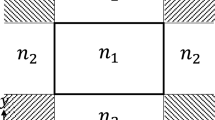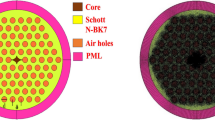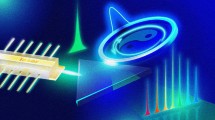Abstract
An analytic circuit model for slot coupling from a waveguide to a loop-gap resonator (LGR) in a context of electron paramagnetic resonance (EPR) spectroscopy is presented. The physical dimensions of the waveguide, iris, LGR, and aqueous sample are transformed into circuit values of inductance, capacitance, and resistance. These values are used in a solution of circuit equations that results in a prediction of the radio frequency (rf) currents, magnitude and phase, frequency, and magnetic and electric stored energies near the critical coupling. The circuit geometry reflects magnetic flux conservation between the iris and LGR as well as modification of the outer loop LGR currents by the iris. Unlike conventional models, coupling is not explicitly based on a mutual inductance between the iris and LGR. Instead, the conducting wall high-frequency rf boundary condition is used to define surface currents, regions, and circuit topology with lumped-circuit values of self-inductance, capacitance, and resistance. Match is produced by a combination of self-inductive and capacitive circuit coupling. Two conditions must be met to achieve match. First, the equivalent resistance of the LGR as seen by the iris must be transformed into the waveguide characteristic impedance. This transformation is met at a particular frequency relative to the natural LGR resonance frequency. The frequency shift magnitude is largely determined by the LGR properties, weakly dependent on the iris length and placement, and independent of other iris dimensions. The second condition for match is that the iris reactance at this frequency shift must cancel the residual reactance of the LGR. This second condition is sensitive to the iris dimensions. If both conditions are not simultaneously satisfied, overcoupling or undercoupling results. A slotted iris with a length equal to the size of the large dimension of the waveguide is found to have many properties opposite to a conventional iris with shorter length. Notably, the magnetic field near the iris tends to reinforce rather than oppose the magnetic field in the resonator. The long iris improves the LGR EPR performance by providing increased rf magnetic field homogeneity at the sample, higher signal, and reduced total frequency shift since the shifts due to sample and iris tend to cancel. Investigations reveal that the first match condition can be adjusted by LGR dimensional changes and such adjustment can eliminate the frequency shift. Results are consistent with Ansoft High Frequency Structure Simulator (Version 10.1, Ansoft Corporation, Pittsburgh, PA) simulations and can be extended to cavity resonators.
Similar content being viewed by others
References
Mett, R.R., Hyde, J.S.: Rev. Sci. Instrum. 76, 014702 (2005)
Froncisz, W., Hyde, J.S.: J. Magn. Reson. 47, 515–521 (1982)
Hyde, J.S., Froncisz, W., in: Hoff, A.J. (ed.) Advanced EPR: Applications in Biology and Biochemistry, pp. 277–306. Elsevier, Amsterdam (1989)
Rinard, G.A., Eaton, G.R., in: Eaton, S.S., Eaton, G.R., Berliner, L.J. (eds.) Biomedical EPR, part B. Biological Magnetic Resonance, vol. 24, pp. 19–52. Kluwer Academic, New York (2004)
Froncisz, W., Oles, T., Hyde, J.S.: Rev. Sci. Instrum. 57, 1095–1099 (1986)
Klug, C.S., Camenisch, T.G., Hubbell, W.L., Hyde, J.S.: Biophys. J. 88, 3641–3647 (2005)
Ginzton, E.L.: Microwave Measurements. McGraw-Hill, New York (1957)
Ramo, S., Whinnery, J.R., Van Duzer, T.: Fields and Waves in Communication Electronics, 2nd edn., sects. 4.12, 7.11, 10.12, 11. Wiley, New York (1984)
Terman, F.E.: Radio Engineers’ Handbook, sects. 2, 3. McGraw-Hill, New York (1943)
Grover, F.W.: Inductance Calculations, p. 3. Van Nostrand, New York (1946)
Mett, R.R., Sidabras, J.W., Hyde, J.S.: Appl. Magn. Reson. 31, 571–587 (2007)
Jackson, J.D.: Classical Electrodynamics, 2nd edn., sect. 8.2, problems 6.5, 6.14. Wiley, New York (1975)
Smythe, W.R.: Static and Dynamic Electricity, 2nd edn., chapt. IV, problem 59. McGraw-Hill, New York (1950)
Marcuvitz, N. (ed.): Waveguide Handbook, chapts. 5, 8. Boston Technical Publishers, Lexington, Mass. (1964)
Brown, R.G., Sharpe, R.A., Hughes, W.L., Post, R.E.: Lines, Waves, and Antennas: The Transmission of Electric Energy, 2nd edn., chapt. 4. Wiley, New York (1973)
Bogle, A.G.: J. Inst. Electr. Eng. 87, 299–316 (1940)
Author information
Authors and Affiliations
Corresponding author
Rights and permissions
About this article
Cite this article
Mett, R.R., Sidabras, J.W. & Hyde, J.S. Coupling of waveguide and resonator by inductive and capacitive irises for EPR spectroscopy. Appl Magn Reson 35, 285–318 (2009). https://doi.org/10.1007/s00723-008-0162-0
Received:
Revised:
Published:
Issue Date:
DOI: https://doi.org/10.1007/s00723-008-0162-0




